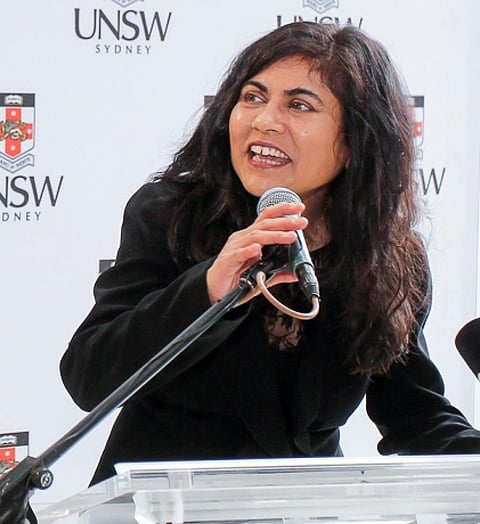‘World’s first e-waste microfactory will create a ripple effect on jobs, especially for local communities’
The world’s first microfactory for e-waste can convert computer circuit boards to metal alloys, and glass and plastic to micro materials used in ceramics and plastic filament. Veena Sahajwalla, a professor at the University of New South Wales (UNSW) is the brain behind this.
This microfactory can prevent electronic waste from going to landfills by turning it into valuable materials for reuse. Here, Sahajwalla, who is an IIT-Kanpur alumnus, explains the idea behind the microfactory and how it is different from other waste recycling units.
Please tell us about the idea-to-practice journey of this microfactory?
The whole concept of examining the way we recycle consumer and industrial waste has been in the making for more than 10 years. The journey wasn’t just about asking what to recycle. I wanted to reframe the question, so it was not about recycling waste but transforming it into a value-added resource and producing the best outcome for environment. This led to a new manufacturing paradigm that includes reforming waste.
The microfactory, which has been in development for about six years, is a holistic solution—different from traditional recycling—as it enables us to synthesise new products from waste. Value addition won’t happen if we think along the lines of traditional recycling, so the microfactory was created to turn waste burden into a profitable new industry.
What’s the short- and long-term objective of this innovation?
Microfactories are about producing a diverse range of products and outcomes, empowering local communities, and creating local jobs. The Sustainable Materials Research and Technology (SMaRT) team at UNSW Sydney has developed the e-waste microfactory as a range of modular factory devices that can safely transform hazardous domestic and industrial e-waste into valuable metal alloys, silicon carbide nanoparticles and plastics for 3D printing.
The aim is to create a ripple effect not only in jobs but also in export markets or local opportunities for local communities. It shakes up the core of our thinking about recycling by synthesising materials that are superior to what the waste was.
In the long term, we need to empower local communities and regional towns where they don’t have to depend on one company to run a process. When it can be done on a small scale at local level, you have naturally got people and communities empowered.
What is the main principle behind the technology deployed in the e-waste microfactory?
Traditional copper smelters will generally burn the plastics away, so value isn’t being created. The microfactory can create a diverse range of products in different modules. There are different sets of controls for inputs like plastics, circuit boards rich in metals and different devices to generate, under controlled conditions, various outputs. All the inputs don’t have to connect to one big smelter.
The microfactory is diverse in that it is a modular system. So, a company, council or organisation could start with one module –plastic filaments for example–and this promotes natural progression up the value chain. Local empowerment is possible as industry pull is already there because we need all these materials for industrial manufacturing.
In a traditional e-waste factory, discarded circuit boards are first placed in a shredder, which breaks down components. In this microfactory, safety is maintained and contamination avoided by a well-controlled and carefully defined set of processing conditions, including temperature control in a small high-temperature furnace. The PCBs (printed circuit boards) are transformed in the furnace to generate resources that are turned into valuable metal alloys and other non-metallic materials. The furnace can also turn glass and plastic into silicon carbide nanoparticles.
Can you give us some examples of the microfactory turning consumer waste into commercial products?
Glass panels and other products like mixed waste panels produced by green microfactories can be used in construction. Blended products can be used to create different properties such as sustainable panels – those can be used in furniture and building construction.
We are studying how materials interact and we might be able to get completely new products with multiple properties.
Is this technology potentially polluting?
We have good control on how we process different inputs, so we don’t generate toxins. The microfactory has relatively small and modular devices, as opposed to large smelters, accelerating production of multiple outputs via selective synthesis, which transforms complex waste into value-added materials.
In developing countries, where 60-90 per cent of e-waste recycling is happening via informal sector, how can a technology like bring about a change?
Microfactories are right kind of solution in a decentralised environment. The informal sector is already established, and it is possible to have separate microfactories – one could do just plastics and one could do all glass. Materials are already being collected in developing countries so it would add a lot of value to the existing waste collection system, by creating value-added resources. Considering that India is the fifth largest producer of e-waste worldwide, delivering new technology such as microfactories that can be decentralised and distributed across various regions, can make a positive contribution to both the economy and the environment.
How much time will it take for this model to be available commercially, also your viewpoint on its commercial viability?
E-waste microfactories could be immediately commercially viable. It would take about one year to work with the SMaRT team and set up the microfactory.
Do you plan to release this project (or patent) in the public domain?
All our technologies are patented and they are available for organisations under an agreement with UNSW.


